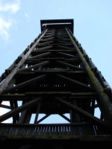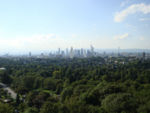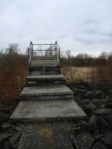Rhein-Main Regional Park
Regional parks as informal tool of spatial planning at the example of Rhein-Main metropolitan area
Rationale: Why is this case study interesting?
Urban agglomerations are growing at the expense of the surrounding landscape. But landscape is more than a resource for ongoing settlement activity.
In order to save the remaining open spaces in between the settlements the idea to establish a Regional park in the Rhein-Main area was conceived. The basic idea is to connect local highlights with a grid of foot- and cycle pathes.
Aim of the case study is to analyse the steps gone on the way to a Regional-park.
Regional parks as strategy to save open spaces can be transferred to metropolitan areas all over the world.
Author's perspective
- What theoretical or professional perspective do you bring to the case study?
Landscape and/or urban context
Natural spatial classification
Urban context
Administrational structure
History
Economy
The Rhine-Mine area is a urban agglomeration in central Germany. It is located in the south of the federal state Hesse. It is a polycentric area named after the core city Frankfurt and the river Rhine and Main. Rhine-Main area is a relative flat area in the northern part of the upper rhine rift. The lowland is surrounded by the low mountain ranges Taunus, Spessart, Odenwald, Hunsrück and Vogelsberg.
- Biogeography, cultural features, overall character, history and dynamics
Illustration: Map; sketches; short descriptive analyses
Cultural/social/political context
- Brief explanation of culture, political economy, legal framework
Illustration: Bullet points, image, background notes
History
Based on the engagement of the joint planning association agglomeration Rhine-Main is the concept of the Regional park beeing realized since the early 90s. Mile stones in the history of the Regional park Rhine-Main were:
Administrational history:
- 1994 Resolution of the planning association Umlandverband Frankfurt (UVF) to implement a Regional park in Rhine-Main agglomeration
- 1995 Foundation of the intermediary company Regional park Rhine Main Pilot gGmbH
- 1997 Foundation of the intermediary company Regional park RhineMain southwest GmbH
- 2000 Foundation of the intermediary company Regional park RhineMain Kornberg / Schwalbach GmbH
- 2001 Foundation of the intermediary company Regional park RhineMain Taunushang GmbH
- 2003 The joint planning association Rhine Main gets project partner in the European Union support programme Interreg III B SAUL (Sustainable and Accessible Urban Landscapes) and SOS II (Sustainable Open Spaces)
- 2004 Foundation of the intermediary company Regional park Hohe Straße GmbH together with the planning association Rhine Main
- 2005 Foundation of the umbrella company Regional park Agglomeration Rhine-Main GmbH. Due legislation the joint planning association Rhine Main is no longer responsible for the Regional park. The new founded umbrella company follows up the concept of a Regional park Rhine Main.
History of the projects:
- How did the area/project/plan at the focus of the case study evolve?
Illustration: Table or time line
Spatial analysis of area/project/plan
- What are the main structural features?
- How has it been shaped? Were there any critical decisions?
Illustration: Map/diagram/sketches photos and background notes
Core Questions Working Group Green Structure Planning
How does funding influence the planning and use of public space?
Funding influences the implementation speed of Regional park routes and the realization of projects. Resources are used more sparingly.
The realization of the Regional park concept is based on several funding pillars. Regional park projects have had an total expense of ca. 30 million Euros yet. The pillars are [1] [2]:
- Joint planning associaton (Planungsverband Ballungsraum Frankfurt/Rhein-Main) ca. 39%
- Partner municipalities (16 %)
- State of Hesse (8 %)
- Sponsorship money (29 %)
- Subsidies from European Union (8 %)
How are spaces within the site used both currently and projected?
Project areas are open spaces in the whole Rhine-Main Agglomeration. Therefore existing open spaces such as parks, woods, meadows agricultural land and allotted special features in the landscape.
Projected is a grid of paths shaped like park paths connecting the existing green axes and the special features.
The grid of paths will be realized as a long termed, project oriented vision. Regional park routes and local Regional park projects are implemented step by step. As informal planning instrument the Regional park concept can only on cooperative basis with all parties concerned and involved.
The steps of realiszation and the development of concepts are consigned by Separate organizations, a umbrella association and implementation association in cooperation with all parties involved.
Consensus planning aims are:
- Save remaining open spaces.
- Creating very attractive open spaces for recreational purposes.
- Accentuation of the beauty of the landscape.
- Creating regional interrelationship.
How can the historic elements / layers be integrated?
The historical development of Rhine-Main region is a combination of circumstances related to natural landscape elements, settlement history and transport development. Settlement development followed the line of the rivers. Trade routes connected these settlements, often they get along the rivers.
River Rhine is till today a major trade route from north to south. River Main is a trade route from west to east. Located at the intersection of the trade routes the conditions of settlement development were convenient. Historical traces in Rhine-Main area reach back to New Stone Age (Neolithic).
Traces from past eras are readable in the Landscape of Rhine-Main-region such as celtic cairns, roman limes, trade routes, castles, historic parks, industrial sites. Historical elements and layers are one integrative part of the Regional-Park concept. Rediscovered and brought back into consciousness a grid of Regional-park routes connect them as destinations. Visible sites are made accessible and hidden traces are often designed by artist or explained via tables or guided tours.
How do the contributing elements of water relate to the project?
The region is named Rhine Main in relation to the both rivers. These rivers are the main water features since the beginning of the settlement history. They're used as resource for water catchment, fishing, for transportation purposes and for recreation.
Water in the Regional park concept need to be considered in two scales. In regional scale and local scale the rivers are a key element in the Regional Park. They're a natural connecting element cross communities and are part of regional green axes. Rhine and Main and its confluences are a natural connecting element. Paths and tracks besides the rivers are embedded into the concept and used as walking and cycling paths.
Small smaller lakes and quarry ponds are also part of the landscape and embedded into the concept. Water as part of a open design is also often a component in the Regional park on a specific site.
How does the built environment relate to the landscape around it?
Rhine Mine region is an metropolitan area in Germany:
- 5.5 million inhabitants (2007)
- Area of 14.755,1 km2
- Core Cities: 1186 km2
- Density of inhabitants: 372 Inhabitans/km2
- 8,3 of Germanys gross value added is generated in Rhine Main.
- Intersection of several traffic systems.
Core Cities are: Aschaffenburg, Darmstadt, Frankfurt a. M., Fulda, Gießen, Hanau, Limburg, Mainz, Offenbach a. M., Wiesbaden und Worms (IHK Rhein-Main)
Main features of the landscape surrounding lowland Rhein Main are low mountain ranges and the biggest rivers Rhine and Main. Rhine Main is a polycentric area around the core city Frankfurt a.M.
Main issues in terms of green structure planning are the loss of open spaces, the loss of biodiversity and the increasing fragmentation of the landscape. Major driving forces are continuous suburbanization, economical growth and the global competition about investments.
With the establishment of a Regional park and the necessary cooperation and processes of participation the goal of a regional identity can be reached.
Analysis of program/function
- What are the main functional characteristics?
- How have they been expressed or incorporated?
Illustration: Map/diagram/sketches photos and background notes
Analysis of design/planning process
- How was the area/project/plan formulated and implemented?
- Were there any important consultations/collaborations?
Illustration: Map/diagram/sketches photos and background notes
Analysis of use/users
- How is the area/project/plan used and by whom?
- Is the use changing? Are there any issues?
Illustration: Map/diagram/sketches photos and background notes
Future development directions
- How is the area/project/plan evolving?
- Are there any future goals?
Illustration: Map/diagram/sketches photos and background notes
Peer reviews or critique
- Has the area/ project/plan been reviewed by academic or professional reviewers?
- What were their main evaluations?
Pleas add references, quotes...
Points of success and limitations
- What do you see as the main points of success and limitations of the area/project/plan?
Illustration: Summary table
What can be generalized from this case study?
- Are there any important theoretical insights?
Short statement plus background notes
Which research questions does it generate?
Short statement plus background notes
Image Gallery
Cooperate design elements
- Yourimage.jpg
your image text
- Yourimage.jpg
your image text
- Yourimage.jpg
your image text
Projects
Over 100 projects within the concept of the Regional park Rhine-Main are realized. The following compilation is not chronological regarding the year of completation. It's only a short insight into the Regional park Rhine-Main. Each of the projects would be a case study for itself, a detailed description of the projects would go beyond the scope of the case study Regional park Rhine Main. For a deeper insight please visit: [3] [4]
Swelling park Kronthal
El-Lissitzky-Alley
Pole pyramid
Goethe tower
Airfield Bonames
Nature protection area Mönchbruch
References
Please add literature, documentations and weblinks
Links in English:
http://www.frm-united.com/Home.9.0.html?&L=1
Links in German:
http://www.regionalpark-rheinmain.de/
http://www.planungsverband.de/
http://www.rhein-mainische-forschung.de/atlas/
http://www.frm-united.com/Home.9.0.html
About categories: You can add more categories by copying the tag and filling in your additional categories



























